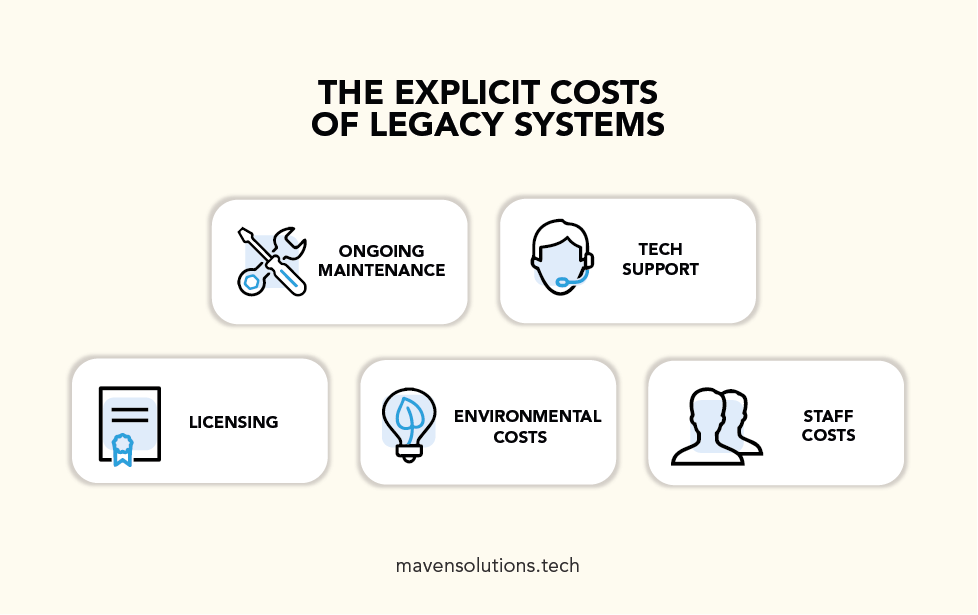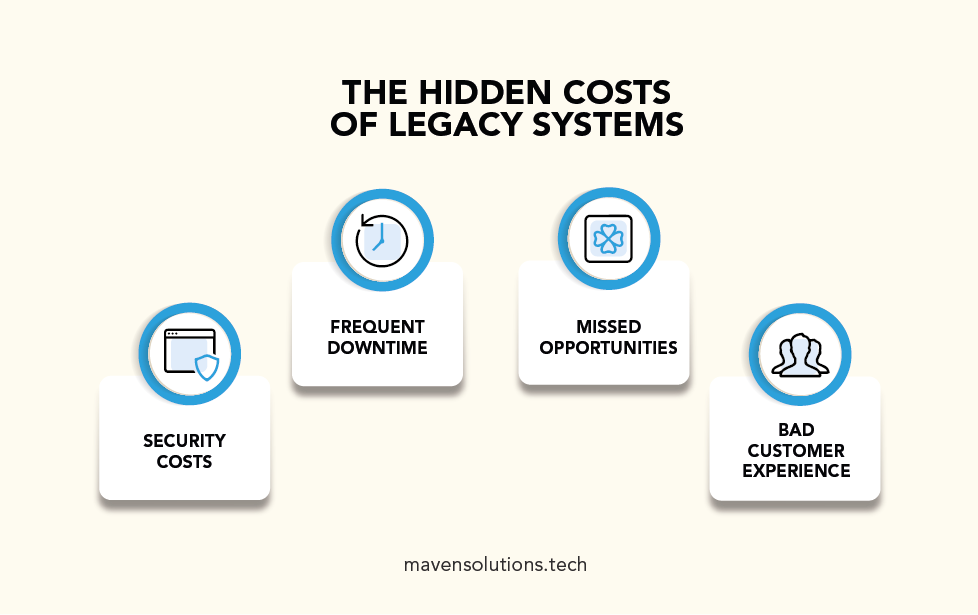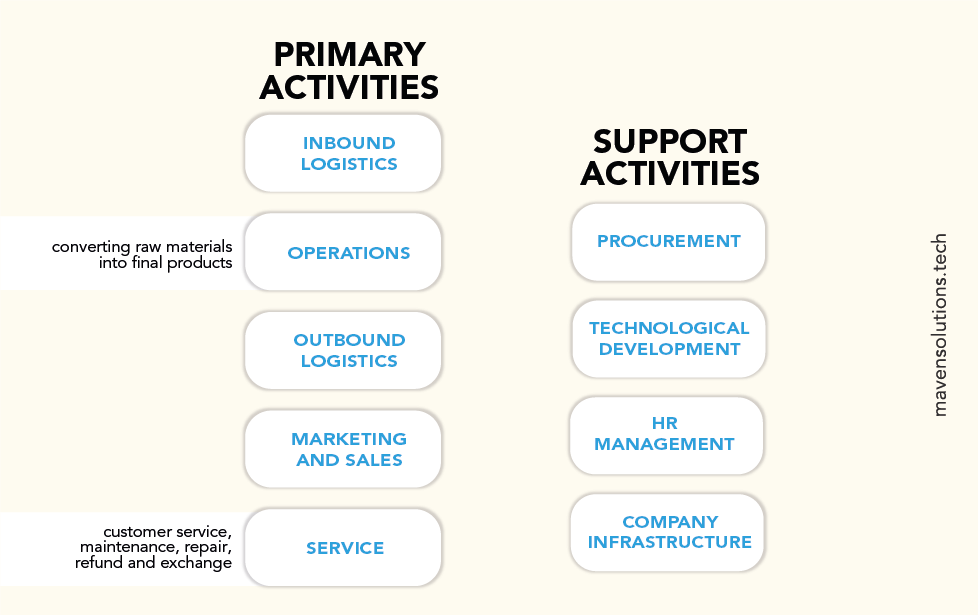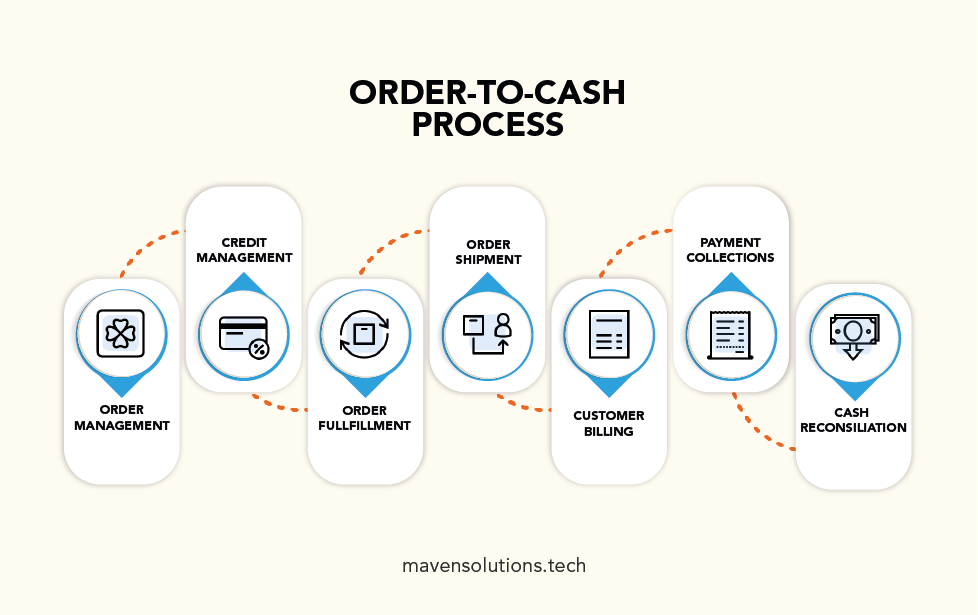 13 min read
13 min read Cost of Maintaining Legacy Software: Top 2 Business Concepts
 13 min read
13 min read Modernizing legacy systems can cost a fortune. The thing is, a legacy system maintenance cost is much higher. The more you wait to begin application modernization, the more you will ultimately need to spend.
However, it can often be difficult to accurately quantify the cost of holding on to legacy systems instead of modernizing them. Supporting outdated systems incurs both surface costs that can be easily quantified and hidden costs that are more difficult to measure but nonetheless impactful. It is important to thoroughly analyze all expenses and determine the most appropriate method for describing them.
This article will present you with a list of expenses to include in your business case, as well as two valuable business concepts that will assist you in describing the cost of maintaining legacy systems.
What Are the Risks Associated with Having Legacy Systems?
Legacy systems are more vulnerable to security threats, such as cyber-attacks, data breaches, and malware. Additionally, they tend to be slower and less reliable, which can cause performance issues, downtime, and system failures. Legacy technology may also not comply with modern regulations and standards, potentially resulting in legal and financial penalties. All of these factors can lead to reputational damage, dissatisfied customers, and loss of revenue.
In addition, as we have already mentioned, maintaining legacy systems is more expensive than modernizing them. According to the United States Government Accountability Office, ten of the government’s legacy systems cost approximately $337 million annually to operate and maintain.
To compare the cost of maintaining legacy systems vs updating them, let’s examine the explicit and hidden costs of legacy technology.
Read more: 5 Signs that You are Facing Legacy Software
The Explicit Costs Associated with Legacy Systems
Explicit costs are direct, out-of-pocket expenses that can be easily identified and measured since they involve the payment of money or other tangible assets. Examples of explicit costs include salaries, rent, materials used in production, insurance, taxes, and electricity bills, among others.

Ongoing Maintenance Costs
A survey conducted by Deloitte found that, on average, IT departments allocate over 55% of their tech budget to maintaining business operations and only 19% to developing innovative solutions.
Due to constant breakdowns and failures, the technology requires significant attention and repair work. Moreover, the hardware and software needed to maintain it cease to be manufactured, and their prices can change as well. Initially, when products reach the end of their life cycle, their prices tend to decrease. However, as stock becomes depleted and the products become more challenging to acquire, one should expect to pay more.
To determine the costs involved in maintaining legacy applications, include expenses related to server maintenance, hardware upgrades and replacements, as well as software patches, upgrades, bug fixes, and security updates.
Tech Support
To operate and support legacy systems, you need experts who have the necessary knowledge and skills, but their numbers are decreasing every year. You must either hire highly skilled professionals experienced in working with what is now considered legacy technology or train your existing staff.
If you choose the first option, be prepared to face difficulties in finding experts who would opt to work with legacy code over modern solutions and who possess the necessary skills to do it effectively. In the second case, you will need to invest time and money in training and education. Both options are quite expensive.
To calculate tech support costs, estimate the expenses related to human resources required to maintain the technology, including salaries, benefits, and training.
Licensing
Legacy systems often require special licensing, usually for software that has been discontinued and is no longer updated by the vendor. This means extra investments are needed to continue utilizing it. For instance, in 2015, the US Navy paid at least US$9 million to safely use Windows XP on their systems.
To include this category of costs, count what you spend on vendor support and third-party software licenses.
Environmental Costs
Older technology consumes a lot of electrical power and requires more cooling infrastructure, whereas modernized technology is generally less power-consuming, smaller in size, and produces less heat.
Sticking to legacy technology is detrimental to your environmental economies of scale. While moving to a cloud-based or on-premises environment is a matter of choice, platforms with new features are often more sustainable. For instance, according to AWS, organizations running in the cloud typically use 77% fewer servers, consume 84% less power, and employ a 28% cleaner power mix. When calculating finances, include bills for electricity, water, gas, and other utilities.
Staff Costs
As we have mentioned earlier, it becomes increasingly difficult to find specialists experienced in working with legacy systems as they age.
If you decide to teach your existing staff, they have to be willing to devote themselves to learning outdated technologies instead of working on exciting modern solutions and gaining skills for further career development. This not only requires a higher avg cost of legacy system programmers’ work, but it is also a recipe for employee burnout, decreased performance levels, and dissatisfaction, leading to more turnovers.
With such consequences, you really have to ask yourself why you need to stick with legacy systems.
This category of costs may include the time spent on activities such as meetings, administrative tasks, and paperwork, as well as the costs of employee turnover and training. Additionally, it may involve the loss of productivity due to equipment breakdowns or other interruptions.
Find out How to Outsource Software Development Right with 12 Reliable Tips from a 12-Year-Old Provider
The Hidden Costs of Legacy Systems
Hidden costs refer to indirect expenses that are not easily identifiable or measurable in a business or individual’s activities. These costs do not involve the direct payment of money or tangible assets, unlike explicit costs. Instead, they represent the opportunity costs or the lost opportunity costs of using resources in one way rather than another.

Security Costs
A legacy application comes with an increased risk of data leakages or data loss in general, which threatens a business’s reputation and finances. According to IBM’s 2019 Cost of Data Breach Report, the average cost of a data breach in the US is $9.44 million.
Counting the hidden costs of safety risks can be difficult, but it’s important to consider expenses related to cybersecurity staff and services, ongoing maintenance checks, security updates, dealing with security breaches, and preparing data recovery plans. You should also assess the risk of security vulnerabilities and the associated cost of mitigating them.
Frequent Downtime
System disruptions require you to allocate your development team’s precious time to fix them, which is both costly and time-consuming. You may also need to attract additional help and pay for consultations or repairs, which further prolongs the time you spend on problem-solving.
Situations like this occur regularly with legacy tech, as outdated technology is much more prone to errors due to its technical debt. It’s important to evaluate the cost of downtime resulting from software maintenance and the potential loss of revenue or productivity. Consider the expenses related to monitoring, fixing bugs, paying for the labor force, and handling customer support requests.
Missed Opportunities
Investing in the maintenance of legacy systems reduces the resources available for innovations that can boost process optimization and improve productivity, resulting in increased revenue. Examples of such innovations include AI or automation.
By forgoing the benefits of modernization, you also prevent the possibility of interconnectivity and integration of your systems with new technologies. Imagine a scenario where you wanted to collaborate with a partner, potentially increasing your income and brand image, but your technology is not compatible, causing you to miss out on this opportunity.
Consider your competitors who have already improved their customer experience after modernizing their applications, and imagine the long-term consequences of continuing to hold onto legacy systems.
To determine the cost of not upgrading a legacy system, research the market share your business could obtain without the influence of legacy technology. Calculate the time your employees invest in dealing with errors instead of focusing on new development that could lead to more achievements and growth.
Bad Customer Experience
Failing to modernize your systems can be detrimental to the customer experience. For your clients, this means having to constantly deal with crashing services and nightmarish interfaces, which can be frustrating and test their patience. Similarly, for employees, interacting with old ERP systems and legacy enterprise software can also be an unpleasant experience.
In today’s highly competitive market, it is essential that you do not undermine customers’ trust or complicate their touchpoints with your systems.
When trying to calculate costs for this category, you will likely encounter the order-to-cash (O2C) or a similar process. O2C involves at least one critical conversion rate. By monitoring this rate over time, you can gain insight into the impact of poor customer experience. This data can be compared with industry-standard conversion rates based on historical data or those comparable to industry averages, allowing for more accurate calculations.
Find Out How to Calculate the Total Cost of Ownership for Software
Two Business Concepts for Describing the Cost of Maintaining Legacy Software
To better understand the cost of sticking to legacy systems instead of investing in application modernization, we recommend utilizing the Value Chain and Order-to-Cash concepts.
The Value Chain Concept
The value chain is a framework that helps businesses describe a complete cycle of business activities that add value to their products or services, starting from receiving the materials to delivering the final product to the market. The value chain includes primary and secondary activities. Its goal is to deliver the maximum value at the lowest possible cost to create a competitive advantage.

Modernizing an application can result in improved functionality, usability, and performance, leading to higher customer satisfaction and increased sales. The benefits of a modernized application can be attributed to faster response times, better user interfaces, and enhanced functionality, all contributing to a better customer experience. Additionally, application modernization can enhance operational efficiency by automating manual processes, streamlining workflows, and reducing errors, resulting in increased productivity and cost savings.
Regarding the cost of maintaining legacy applications, you can determine the direct and indirect dependencies of the value chain on legacy software. As several dependencies may impact legacy applications, calculating the costs and revenue for each process action can help identify the critical parts of the value chain. By ranking them based on their highest cost and revenue and relating them to the legacy software, you gain valuable insights into the most effective application modernization that can be carried out.
Order-to-Cash Concept
The Order to Cash (O2C) process refers to the set of business activities that start with receiving an order from a customer and end with receiving payment and finalizing the sale. The process can be modified to suit the business model, such as Subscription-to-Cash, Quote-to-Cash, or other variations.

Application modernization can have a significant impact on the O2C process by simplifying and automating its various stages, resulting in enhanced efficiency and increased satisfaction for both employees and customers. Automating the tracking and management of inventory levels, shipping, and delivery enhances the order fulfillment process, while the adoption of electronic invoicing and payment systems automates the invoicing process and reduces errors. In addition, automating the payment processing stage streamlines the payment collection and reconciliation process.
Regarding the cost of maintaining legacy systems, O2C-like processes are typically a funnel with various stages that filter out a portion of customers through conversion rate. Legacy software can have a direct or indirect impact on these conversion rates. By identifying the most significant drop-off, especially compared to industry standards and market specifics, and relating it to the legacy software, you can gain insight into where modernization efforts are best applied.
How Much Do You Overpay to Maintain Legacy Software?
The amount of money you overpay to maintain legacy software depends on several factors, such as the size and complexity of the software, the number of users, the level of support required, and the age of the software.
One way to approximate the degree of overpayment is to compare the expenses of maintaining legacy applications with those of developing new software or replacing it with modern technology. To accomplish this, consider the total cost of ownership of the legacy system, including human resources, support from the ERP vendor, potential downtime, hardware maintenance, software maintenance expenses, and other related costs.
In the end, the decision to maintain legacy software or invest in modernization initiatives should be based on a cost-benefit analysis that considers the long-term financial implications, the risks associated with maintaining an outdated system, and the potential benefits of modernizing the system.
Conclusion
Continuing to maintain legacy technology means losing money for your business without any return. At first, when comparing the cost of modernization to the cost of doing nothing, it may seem like paying for the maintenance of expensive legacy platforms is a better choice. However, taking into account both explicit and implicit costs, as well as utilizing Value Chain and Order-to-Cash concepts to describe the expense of sticking to legacy tech systems, will provide a clear understanding of the necessity to modernize.
If you are looking for a reliable partner with over 12 years of experience, Maven can help you execute the most efficient modernization plan while providing the maximum value in the minimum time to market. Contact us to discuss your business needs.
FAQ
Why changing the legacy system is expensive?
Changing the legacy system can be expensive because of its scope and complexity, especially when it comes to extremely outdated enterprise systems. However, while updating a legacy system can be expensive in the short term, the long-term benefits often outweigh the initial costs.
How do you maintain a legacy system?
Some common activities for maintaining a legacy system are documentation, bug fixing and patching, performance monitoring and optimization, knowledge transfer and training, legacy system support contracts, etc.
Is it profitable to replace the legacy system?
The profitability of replacing a legacy system depends on various factors specific to the organization and the legacy system itself. It is essential to consider the costs, risks, and potential return on investment (ROI) associated with the replacement before starting the process.
Why do companies still use legacy systems?
Companies continue to use legacy systems for different reasons. Some of the most common ones are lack of budget for modernization, data and operational dependencies, fear of risk and new challenges, and integration challenges.
Are legacy systems reliable?
While some legacy systems may still be reliable and continue to operate without major issues, most are not reliable and problematic due to outdated technologies, lack of vendor support, or inadequate maintenance.
When should I replace my legacy system?
Replacing legacy technology is needed when it hinders your business processes and delivers more problems than benefits.







 15 min read
15 min read